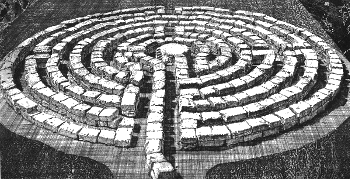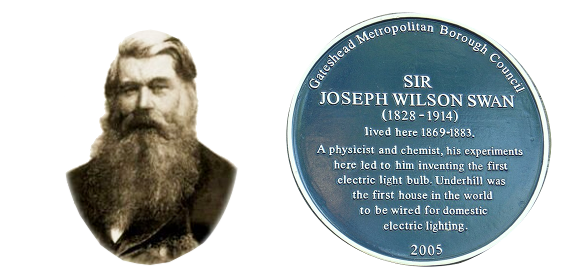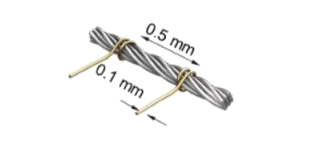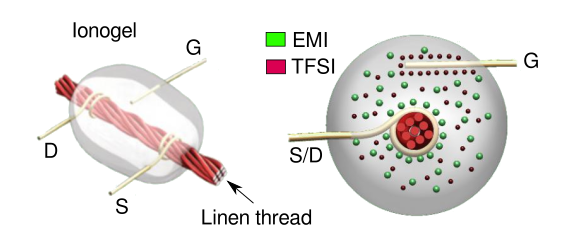Transistor Threads
October 7, 2019
One downside of being
human is
mortality, and people have always wondered why some people
die young, while others
live a long life. The
ancient Greeks imagined that such
destiny was wrought by a trio of beings who were the
instantiation of destiny. These were called the
Moirai (Μοιραι,
Fates in English). There was
Clotho (Κλωθω), who who spun a
thread of
life,
Lachesis (Λαχεσις), who measured out a length, and
Atropos (
,Ατροπος), who cut the allotted length.

The Three Fates (Moirai), Clotho, Lachesis, and Atropos.
(Wikimedia Commons photograph by Andreas Praefcke of a sculpture by Johann Gottfried Schadow (1764-1850).)
(Click for larger image.)
A thread is an important part of another story in
Greek mythology, that of
Ariadne,
Theseus, and the
Minotaur. The Minotaur was creature with the
head of a
bull and the
body of a
man that lived at the
center of a
maze-like structure called the
Labyrinth. According to the story, Theseus was among a group of young men and women being
sacrificed to the Minotaur.
Ariadne gave Theseus a
sword to
kill the Minotaur, and also a
ball of thread to allow him to find his way out of the labyrinth once this had been done.
Ariadne's thread is now the name of a
method of
exhaustive search in which you test each path at a
logical juncture, and back-track to the last last state when the trial leads to a dead end. Either a
solution is reached, or all possible paths have been tested to ensure that there is no solution.

A depiction of the Labyrinth.
While it is clear from the myth that this maze was a complex branching maze with dead-ends, most classical depictions showed the Labyrinth as being unicursal; that is, just a long single corridor.
(A 2007 Wikimedia Commons image by Toni Pecoraro.)
A thread is an important part of another story from
antiquity, that of the
Sword of Damocles. In this story,
Damocles is envious of the
lifestyle of
King Dionysius, so Dionysius offers to make him
king for a day. When Damocles is seated at the king's
throne, he is surprised to see that Dionysius had a sword suspended above the throne by a single
hair of a horse's tail. The
lesson was that being
king has its dark side, also, since there is always the fear of internal and external
enemies. From this story comes the
adage,
to hang by a thread, which is included in the
16th century book of famous adages,
Adagia, by the
Dutch scholar,
Erasmus (1466-1536).
Threads were a very important stage in the development of the
incandescent light bulb.
Joseph Swan (1828-1914), an
English physicist,
chemist, and
inventor, was one of the first to develop a successful incandescent light bulb, demonstrating ever improved versions from 1875 onward. All of these used
carbon filaments in a
vacuum glass bulb, some of the better filaments created by
carbonizing cotton thread. He
commercialized his
invention by lighting
homes and the
Savoy Theatre, London.
Thomas Edison similarly tested carbonized thread in his early light bulbs.[1]

English physicist, chemist, and inventor, Joseph Swan (1828-1914), and a commemorative plaque marking his electrically-lighted house. Since Swan and Edison both had strong patent positions in Great Britain, their companies merged there in 1883 to create the Edison & Swan United Electric Light Company. (Left, Joseph Swan from Wikimedia Commons. Right, a Wikimedia Commons image by HJ Grey. Click for larger image.)
A team of
engineers from
Tufts University (Medford, Massachusetts) has recently developed a
transistor made from
linen thread.[2-3] This
field-effect transistor is enabled by an
ionic gate, and the allure of such a transistor is that it might be
woven into
fabric or more easily
implanted surgically for
diagnostic monitoring since they are extremely thin, soft and
flexible.[3] Compared with flexible
electronics based on
polymers and other
materials, these thread-based electronics have superior flexibility,and they can be
manufactured without the need for a
cleanroom.[2-3] I wrote about ion-gated transistors in a
recent article (Ion-Gated Transistors, July 1, 2019). As the authors write in their
abstract in
ACS Applied Materials and Interfaces,
"...Real-time monitoring of human biomarkers is becoming increasingly important to modern medicine and patient wellness. Such monitoring is possible due to advances in soft and flexible materials, devices and bioelectronics systems. Compared to other flexible platforms, multifilament textile fibers or threads offer superior flexibility, material diversity, and simple ambient processing to realize a wide range of flexible devices such as sensors, electronics, and microfluidics."[2]

Dimensions of the thread based field-effect transistor.
(Portion of an image from the Tufts University Nano Lab, also available here.)
The thread acts as a
substrate for a
carbon nanotube semiconducting network formed between the
source and
drain electrodes. The ionic gate is a
colloidally dispersed gel of
silica nanoparticles, and the
ionic liquids,
1-ethyl-3-methylimidazolium, and
bis(trifluoromethylsulfonyl)imide (EMI-TFSI).[2] The
manufacturing process involves
coating a linen thread with carbon nanotubes, attaching two thin
gold wires for the source and drain connections, and surrounding the thread with the electrolyte gel, called an
ionogel, that's connected to the gate electrode.[3] Unlike the gate material in conventional transistors, the ionogel can stretch and flex along with the thread.[3]

Top and cross-sectional views of the thread-based field-effect transistor. The source (S) and drain (D) connections are to the carbon nanotube coating on the thread. The gate connection is through an electrolytic gel, and a gate voltage above a threshold will cause a flow of electrons through the transistor. The gel electrolytes are 1-ethyl-3-methylimidazolium (EMI), and bis(trifluoromethylsulfonyl)imide (TFSI) (Reformatted image from the Tufts University Nano Lab, also available here. Click for larger image.)
Not only did the Tufts research team fabricate working thread transistors, they also interconnected them to form functioning
logic gates and small-scale
integrated circuits.[2] They developed thread-based sensors for
temperature,
glucose, and
strain.[3] They also created
microfluidic threads for drawing
fluids from surrounding
tissues, and for dispensing
drugs.[3] They created an integrated circuit
multiplexer and connected it to thread-based sensors for detecting
sodium and
ammonium ions, which are
diagnostic of
liver and
kidney function.[3] Says
Rachel Owyeung, a
graduate student at the
Tufts University School of Engineering and the first
author of the study.
"In laboratory experiments, we were able to show how our device could monitor changes in sodium and ammonium concentrations at multiple locations... Theoretically, we could scale up the integrated circuit we made from the TBTs to attach a large array of sensors tracking many biomarkers, at many different locations using one device."[3]
The utility of such thread-based biosensors is summarized by
Sameer Sonkusale, a
professor of
electrical and computer engineering at Tufts University School of Engineering and the corresponding author of the study, "There are many medical applications in which
real-time measurement of biomarkers can be important for treating
disease and monitoring the
health of patients. The ability to fully integrate a soft and pliable diagnostic monitoring device that the patient hardly notices could be quite powerful."[3]
This research was supported by the
National Science Foundation.[3]
References:
- Thomas Alva Edison, "Electric lamp," U.S. Patent No. 223,898, January 27, 1880.
- Rachel E. Owyeung, Trupti Terse-Thakoor, Hojatollah Rezaei Nejad, Matthew J. Panzer, and Sameer R. Sonkusale, "Highly Flexible Transistor Threads for All-Thread Based Integrated Circuits and Multiplexed Diagnostics," ACS Appl. Mater. Interfaces, August 5, 2019, https://doi.org/10.1021/acsami.9b09522.
- Mike Silver, "Engineers make transistors and electronic devices entirely from thread," Tufts University Press Release, August 21, 2019.
Linked Keywords: Human; mortality; death; youth; longevity; long life; ancient Greece; ancient Greeks; destiny; instantiation; Moirai; Fates; Clotho; thread (yarn); life expectancy; Lachesis; Atropos; Three Fates; Wikimedia Commons; Andreas Praefcke; Johann Gottfried Schadow (1764-1850); Greek mythology; Ariadne; Theseus; Minotaur; head; bull; body; man; center (geometry); maze; Labyrinth; human sacrifice; sword; animal slaughter; kill; sphere; ball; Ariadne's thread; algorithm; method; brute-force search; exhaustive search; logic; logical; juncture; problem solving; solution; branch (computer science); branching; classics; classical; hall; corridor; Toni Pecoraro; antiquity; Sword of Damocles; Damocles; lifestyle (sociology); Dionysius II of Syracuse; King Dionysius; throne; horsehair; hair of a horse's tail; lesson; monarch; king; enemy; enemies; adage; 16th century; book; Adagia; Dutch people; scholarly method; scholar; Erasmus (1466-1536); incandescent light bulb; Joseph Swan (1828-1914); English; physicist; chemist; invention; inventor; carbon; filament; vacuum; glass; carbonization; carbonize; cotton; commercialization; commercialize; home; Savoy Theatre, London; Thomas Edison; commemorative plaque; electric light; house; patent; Great Britain; company; companies; merger; Edison & Swan United Electric Light Company; >HJ Grey; electrical engineering; engineer; Tufts University (Medford, Massachusetts); transistor; linen; field-effect transistor; ion; ionic; gate; weaving; woven; textile; fabric; implant (medicine); surgical implant; diagnostic; sensor; monitor; deflection (engineering); flexible; electronics; polymer; material; manufacturing; manufacture; cleanroom; abstract; ACS Applied Materials and Interfaces; biomarker (medicine); medicine; patient; health; wellness; bioelectronics; bioelectronics system; room temperature; ambient; microfluidics; Tufts University Nano Lab; substrate; carbon nanotube; semiconductor; semiconducting; electrode; colloid; sispersion (chemistry); disperse; gel; silicon dioxide; silica; nanoparticle; ionic liquid; 1-ethyl-3-methylimidazolium; bis(trifluoromethylsulfonyl)imide; coating; gold; wire; ion gel; ionogel; cross-section; electrolyte; electrolytic; gel; voltage; threshold voltage; electric current; flow of electrons; logic gate; integrated circuit; temperature; glucose; deformation (mechanics); strain; fluid; tissue (biology); harmaceutical drug; multiplexer; sodium; ammonium; ions; diagnosis; liver; kidney; Rachel Owyeung; postgraduate education; graduate student; Tufts University School of Engineering; author; laboratory; experiment; Sameer Sonkusale; professor; electrical and computer engineering; real-time computing; disease; health; National Science Foundation.